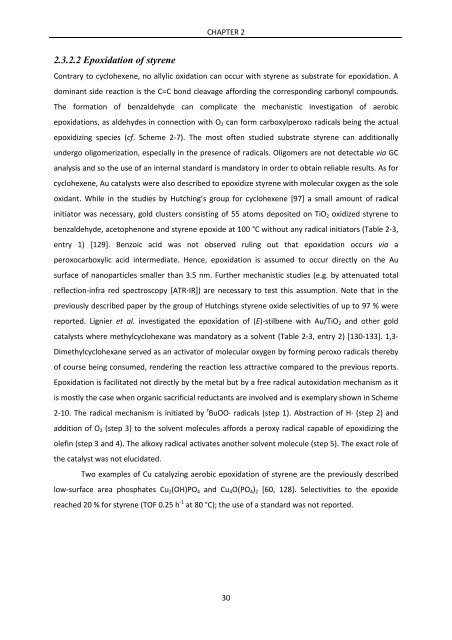Heterogeneously Catalyzed Oxidation Reactions Using ... - CHEC
Heterogeneously Catalyzed Oxidation Reactions Using ... - CHEC
Heterogeneously Catalyzed Oxidation Reactions Using ... - CHEC
You also want an ePaper? Increase the reach of your titles
YUMPU automatically turns print PDFs into web optimized ePapers that Google loves.
2.3.2.2 Epoxidation of styrene<br />
CHAPTER 2<br />
Contrary to cyclohexene, no allylic oxidation can occur with styrene as substrate for epoxidation. A<br />
dominant side reaction is the C=C bond cleavage affording the corresponding carbonyl compounds.<br />
The formation of benzaldehyde can complicate the mechanistic investigation of aerobic<br />
epoxidations, as aldehydes in connection with O2 can form carboxylperoxo radicals being the actual<br />
epoxidizing species (cf. Scheme 2‐7). The most often studied substrate styrene can additionally<br />
undergo oligomerization, especially in the presence of radicals. Oligomers are not detectable via GC<br />
analysis and so the use of an internal standard is mandatory in order to obtain reliable results. As for<br />
cyclohexene, Au catalysts were also described to epoxidize styrene with molecular oxygen as the sole<br />
oxidant. While in the studies by Hutching’s group for cyclohexene [97] a small amount of radical<br />
initiator was necessary, gold clusters consisting of 55 atoms deposited on TiO2 oxidized styrene to<br />
benzaldehyde, acetophenone and styrene epoxide at 100 °C without any radical initiators (Table 2‐3,<br />
entry 1) [129]. Benzoic acid was not observed ruling out that epoxidation occurs via a<br />
peroxocarboxylic acid intermediate. Hence, epoxidation is assumed to occur directly on the Au<br />
surface of nanoparticles smaller than 3.5 nm. Further mechanistic studies (e.g. by attenuated total<br />
reflection‐infra red spectroscopy [ATR‐IR]) are necessary to test this assumption. Note that in the<br />
previously described paper by the group of Hutchings styrene oxide selectivities of up to 97 % were<br />
reported. Lignier et al. investigated the epoxidation of (E)‐stilbene with Au/TiO2 and other gold<br />
catalysts where methylcyclohexane was mandatory as a solvent (Table 2‐3, entry 2) [130‐133]. 1,3‐<br />
Dimethylcyclohexane served as an activator of molecular oxygen by forming peroxo radicals thereby<br />
of course being consumed, rendering the reaction less attractive compared to the previous reports.<br />
Epoxidation is facilitated not directly by the metal but by a free radical autoxidation mechanism as it<br />
is mostly the case when organic sacrificial reductants are involved and is exemplary shown in Scheme<br />
2‐10. The radical mechanism is initiated by t BuOO∙ radicals (step 1). Abstraction of H∙ (step 2) and<br />
addition of O2 (step 3) to the solvent molecules affords a peroxy radical capable of epoxidizing the<br />
olefin (step 3 and 4). The alkoxy radical activates another solvent molecule (step 5). The exact role of<br />
the catalyst was not elucidated.<br />
Two examples of Cu catalyzing aerobic epoxidation of styrene are the previously described<br />
low‐surface area phosphates Cu2(OH)PO4 and Cu4O(PO4)2 [60, 128]. Selectivities to the epoxide<br />
reached 20 % for styrene (TOF 0.25 h ‐1 at 80 °C); the use of a standard was not reported.<br />
30



